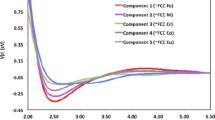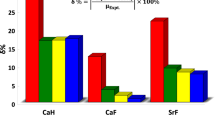Abstract
The second order pseudopotential theory suggests the possibility of a break-up of the total energy of simple metals into a purely volume-dependent part and an effective central pairwise interaction between ions. In the present paper finite contributions for these two parts of the energy have been extracted in a form convenient for calculation. Using the local Heine-Abarenkov model potential, a reliable effective ion-ion interaction is generated and the volume-dependent energy is calculated for Al. The relative contributions of the effective interaction and the volume-dependent energy term to various metallic properties are also calculated. The importance of volume dependence on the effective interaction is also discussed.
The interactomic force constants upto eighth neighbour are derived from the effective interaction and it is found that the force constants beyond the third neighbour are negligibly small. This result is also confirmed by the calculation of dispersion curves with force constants obtained from the effective interaction upto the third neighbour which is found to reproduce the results of the full pseudopotential calculations. The force constants obtained are also used to study some finite temperature properties of Al in the quasi-harmonic approximation and the limitations of the theory are pointed out.
Similar content being viewed by others
References
American Institute of Physics Handbook 1972 3rd edition (New York: McGraw-Hill)
Cochran W 1963Proc. R. Soc. (London) A276 308
Cohen M H 1962Metallic solid solutions (eds) J Friedel and A Guinier (New York: Benjamin)
Dagens L, Rasolt M and Taylor R 1975Phys. Rev. B11 8 2726
Finnis M W 1975J. Phys. F5 2227
Gerasimov V M 1978Sov. Phys. Solid State 20 1486
Hafner J 1975Z. Phys. B22 351
Harrison W A 1963Phys. Rev. 129 2503, 2512
Harrison W A 1966Pseudopotentials in the theory of metals (New York: Benjamin) p. 45
Kormer C B, Funtikov A I, Urlin V D and Kolesnikova A N 1962Sov. Phys. JETP 15 477
Rasolt M and Taylor R 1975Phys. Rev. B11 8 2717
Sen D 1982United study and effective interaction in metals Ph.D. Thesis (University of Calcutta).
Sen D, Sarkar S K, Roy D and Sengupta S 1981Phys. Rev. B24 876
Shyu W M and Gaspari G D 1967Phys. Rev. 163 667
Shyu W M and Gaspari G D 1968Phys. Rev. 170 687
Simmons G and Wang H 1971Single crystal elastic constants and calculated aggregate properties (Cambridge: MIT Press)
Soma T and Satoh T 1980J. Phys. F10 1081
Takanaka K and Hara H 1973Prog. Theor. Phys. 50 1132
Takanaka K and Yamamoto R 1977Phys. Status Solidi B84 813
Taole S H and Glyde H R 1979Can. J. Phys. 57 1870
Vaidya S N and Kennidy G C 1970J. Phys. Chem. Solids 31 2329
Wallace D C 1969Phys. Rev. 182 778
Zeldovich Ya B and Raizer Yu 1967Physics of shock waves and high temperature hydrodynamic phenomena (New York: Academic Press) Vol. 2
Author information
Authors and Affiliations
Rights and permissions
About this article
Cite this article
Sarkar, A., Sen, D. & Sengupta, S. Pseudopotential theory of effective interaction in simple metal. Pramana - J Phys 20, 491–501 (1983). https://doi.org/10.1007/BF02846284
Received:
Revised:
Issue Date:
DOI: https://doi.org/10.1007/BF02846284




